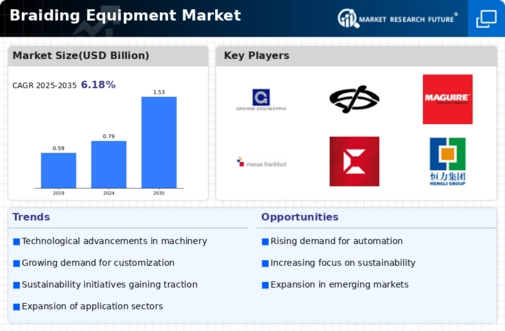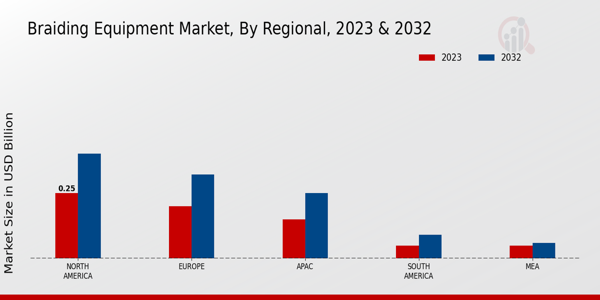Market Trends and Projections
The Global Braiding Equipment Market Industry is characterized by various trends and projections that shape its future landscape. The market is expected to grow from 0.79 USD Billion in 2024 to 1.53 USD Billion by 2035, indicating a robust trajectory. The compound annual growth rate (CAGR) of 6.19% from 2025 to 2035 reflects the increasing adoption of advanced technologies and the rising demand for customized solutions. Key trends include the integration of automation in manufacturing processes and the growing emphasis on sustainability. These factors collectively contribute to the evolving dynamics of the braiding equipment market, suggesting a promising outlook for stakeholders.
Growth of the Textile Industry
The Global Braiding Equipment Market Industry is significantly influenced by the growth of the textile industry, which is experiencing a resurgence due to increasing consumer demand for innovative fabrics and materials. The rise in fashion trends and the popularity of athleisure wear contribute to this growth, necessitating advanced braiding equipment capable of producing intricate designs and patterns. As the textile sector expands, manufacturers are investing in modern braiding technologies to meet the evolving needs of consumers. This trend is expected to sustain a compound annual growth rate (CAGR) of 6.19% from 2025 to 2035, indicating a robust future for braiding equipment in the textile domain.
Emerging Markets and Global Expansion
Emerging markets are becoming pivotal in the Global Braiding Equipment Market Industry, as countries in Asia-Pacific and Latin America experience rapid industrialization and urbanization. These regions are witnessing a surge in demand for braiding equipment across various sectors, including automotive, textiles, and medical devices. As local manufacturers seek to enhance production capabilities and meet international standards, investments in advanced braiding technologies are increasing. This trend is likely to foster global expansion, enabling companies to tap into new markets and diversify their product offerings. The growth potential in these regions may significantly contribute to the overall market dynamics in the coming years.
Rising Demand for Customized Products
The Global Braiding Equipment Market Industry experiences a notable increase in demand for customized products across various sectors, including automotive, aerospace, and textiles. As industries strive to differentiate their offerings, the need for specialized braiding equipment that can produce unique designs and specifications becomes paramount. This trend is particularly evident in the automotive sector, where manufacturers seek lightweight and durable materials for components. The market is projected to reach 0.79 USD Billion in 2024, reflecting the growing inclination towards tailored solutions. This shift towards customization is likely to drive innovation in braiding technology, further enhancing the industry's growth prospects.
Increased Adoption in Aerospace Applications
The Global Braiding Equipment Market Industry is witnessing increased adoption of braiding technology in aerospace applications, driven by the need for lightweight and high-strength materials. Aerospace manufacturers are increasingly utilizing braided composites for components such as fuselage structures and engine parts, where weight reduction is critical for fuel efficiency. The demand for advanced braiding equipment that can produce these specialized materials is on the rise. This trend aligns with the broader industry shift towards sustainable practices, as lighter components contribute to lower emissions. As a result, the market is poised for growth, with projections indicating a potential doubling in value by 2035.
Technological Advancements in Braiding Equipment
Technological advancements play a crucial role in shaping the Global Braiding Equipment Market Industry. Innovations such as automation, computer numerical control (CNC) systems, and advanced materials are revolutionizing the manufacturing processes. These technologies enhance production efficiency, reduce waste, and improve product quality. For instance, the integration of CNC technology allows for precise control over the braiding process, resulting in higher accuracy and consistency. As manufacturers adopt these cutting-edge technologies, the market is expected to witness significant growth, with projections indicating a rise to 1.53 USD Billion by 2035. This technological evolution is likely to attract investments and foster competitive advantages within the industry.












